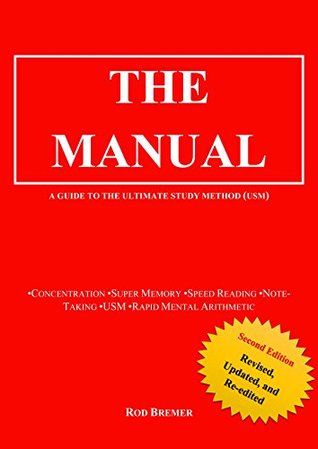
What is the name of the book and when was it published?
The Manual: A Guide to the Ultimate Study Method (Second Edition). The Kindle version was published December 19, 2015 and the hardcover on January 20th, 2016.
What’s the book’s first line?
There exists a profusion of books written about faster forms of learning and about techniques for greater utilization of the mind.
What’s the book about? Give us the “pitch”.
I wanted to distill into an easy-to-follow procedure the elements necessary for optimal learning. The idea was to have a step-by-step procedure to study any topic. And to be able to enjoyably do so in the minimum amount of time, with maximum comprehension, with long-term recall, and—importantly—while stimulating transferability.
What inspired you to write the book? A particular person? An event?
I have found that there are plenty of books on the topics of concentration, memory, speed reading and note-taking. Separately, I have also found excellent resources on optimal study techniques. However, the optimal study techniques did not always cover the aforementioned topics (and, where they did, only partially so). And, equally, texts on the aforementioned topics did not focus on assimilating them into a practical study technique.
This seemed strange, for optimum results can only be achieved when the best aspect of each underlying component is being utilized. So this is what got me started on the idea of the Ultimate Study Method (USM).
In terms of shaping the work, another key factor came into play. After having read through many books and having taken courses on said topics, I found that there were material variations in claims about concentration, memory, speed reading (in particular), and note-taking. For example, some speed reading systems advertise reading rates of 25,000+ words per minute, whereas others are in the range of 1,000 to 5,000. This led me to focus much of my work on researching the scientifically-established facts, to weed out the components that did not consistently deliver optimal results. To eliminate the fantastical and to capture the real and practical.
And there was one more key factor: very early on in my life, I came to realize that the education system is frozen at some Victorian point in time. The scientific research to date has produced some startlingly significant findings, yet few of these have been adopted. And as better schools, or expensive tutoring, bridge the gaps, the future economic inequality tilts undesirably further. I thought it would be a good idea if the playing field could somehow be leveled.
What’s the main reason someone should really read this book?
The most frequent comments I hear are: “why don’t they teach this at school” and “I wish I read this 20 years ago.”
If you are a student or a lifelong autodidact, why waste time on methods that do not deliver optimal results?
If you are a teacher, why use rote learning? Why disown information taught in previous years under the assumption that it will forever stay in the student’s mind? Why not let our method of educating catch up to our level of understanding of the brain’s learning capacity?
New knowledge can either be accumulated by drudgery and kept in short-term memory, or it can be soothingly absorbed, perpetually enjoyed, and allowed to mix and grow with existing knowledge. I believe the system in my book allows the practitioner to enjoy the latter.
So I would say that anyone who wishes to develop a lifelong skill that would transform his/her ability to study anything, ought to read the book.
